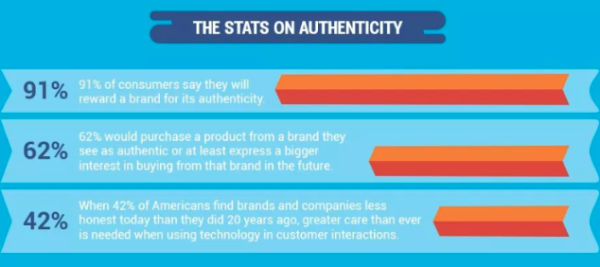Storytelling is something human beings have been doing for millennia, and there's something deeply human about the process of imparting information from one person to another in the form of a great tale.
Just take a second to think about your favorite movie; perhaps it's The Godfather, or maybe Harry Potter? Whatever it is, the narrative has clearly had a profound impact on you, to the point where you just can't help but go back and watch it over again.
It's these same narrative hooks and gently unfolding yarns that are used so effectively by some of the world's biggest corporations, and no matter whether you're a start-up or an established SME, there's no reason that you can't do the same.
Creating a culture that gently caresses each of the stories you're putting out to your audience, when done correctly, has the ability to form relationships that can last for years.
In this blog, I'll detail how to turn your company story into your greatest marketing tool.
Products and marketing aren't enough
What's the first thing you think of when you consider a start-up or small business? In most cases, you're immediately drawn to the product or service on offer. This, after all, is the "what" behind the business.
But, the truth is that "what" on its own isn't enough. Of course, a product or service is vital to the lifeblood of a business, and marketing those wares, is, without doubt, a crucial component to success.
But, to illustrate my point, I Googled the phrase "why marketing isn't enough," and here's what I found:

These are just the top four search results, but believe me, there are many similar articles. What this tells us is that businesses with perfectly good products and sound marketing campaigns are finding life difficult in a way that they never expected.
This is because, as I mentioned, marketing and products are just parts of the overall process.
This, in itself, creates a bigger problem: no matter where and how you decide to market yourself, the channel you're using will always dictate the rules of play.
Facebook, for example, will decide how your images are displayed and will offer next to no organic reach for businesses these days.
Beating your competition to rank at the top of Google for your key search terms and phrases is a battle that could take years to win if you ever do at all.
Whatever search engine, social platform, or marketplace you decide to use, you'll always find that you're limited by the confines that have been laid out before you. Plus, each of your competitors are using precisely the same tools and platforms as you are, and therefore they're also facing the same limitations.
This means that even if you're selling a better product or formulating a superior marketing campaign, there's no guarantee that your business will be the one that stands out above the rest.
Which poses two questions:
• What can your business do to avoid being just another drop in the ocean?
• How can you arm yourself with the right strategies and tools that are proven and effective?
As it turns out, the answer has been in front of you since the day your business opened its doors: focus on your company culture, brand story, and how those two elements come together to make an impact on your audience.
Say, "Goodbye" to sticky notes and mixed-up spreadsheets! 👋 Say, "Hello!" to Keap and get organized like Katie.🎉💯
— Keap (@KeapGrowing) August 24, 2020
What is one thing item in your business you would love to get organized? pic.twitter.com/ymtoF9H1js
Your audience craves the narrative
Remember what I noted earlier: "The Narrative" and how once a story that resonates with you gets its hooks in, it simply refuses to let go? If you've ever wondered why that is, this Quora thread provides a fascinating insight into why we hold storytelling so dear. It explains that humans are complex beings, and for thousands of years, stories have proved such a productive outlet for us to understand the here and now, the past, and what the future may hold. After all, the best story can make us laugh, cry, and formulate genuine attachments to those who appear within them.
That emotional connection can be just as potent in marketing circles. Marketing messages that are delivered in the form of a story are actually 22 times more likely to stick with a prospect than the presentation of simple facts alone.
This suggests that your audience members are crying out for something more memorable and energizing to sink their teeth into. But, once again, this isn't as simple as it sounds. While, yes, we are more interconnected than we've ever been, the rise in ad-fatigue has made marketing, in all its forms, more challenging than ever. So, the question remains, how do you create a strong, reliable, and actionable narrative?
First, you need to really understand the kind of thing you want to put out there, since, as per the OneSpot infographic, almost 80% of consumers report that they still value relevance in the content they consume. This process must start with two steps:
• Step 1: Decide on an angle for your story that is relevant, but will also pack an emotional punch.
• Step 2: Use the right platform to ensure this message is imparted in its best form.
This article from Express Writers states that emotionally invested consumers are actually 52% more valuable to your business, and as you'll see in the paceco.com graphic below, wonderous things can begin to happen to your business once you've picked the lock of the emotional safe:

As previously noted, to do this, you'll need to produce highly relevant, data-driven, quality content that connects with your audience.
Remember the old saying: the customer is always right. They know what they want better than you do, so it's up to you to figure what that is and put it in front of them.
If you can create the content that tells your story and places value on authenticity, then you can't lose.
Your culture defines the experience of your customer
When your company is looking to improve conversion rate optimization and customer retention, you'd be foolish to ignore the journey that each prospect takes before they buy from you.
Savvy business owners understand that fantastic company culture drives productivity and ultimately increases profitability. However, on the flip side, the experience that you're offering your customers will ultimately decide whether they do business with you over the long-term or not.
After all, a bad experience will cost your business money and can spread negativity in no time at all. But a good experience will help to reinforce your reputation amongst that customer's friends and family.
How you and your team interact with potential customers ultimately decides whether they will face a negative or positive experience, but once you're able to really nail the customer journey, you will begin to see positive growth sprouting throughout your business.
So, if you're genuinely committed to creating a joyous experience for your customers, you'll have to really dig deep and understand that how a customer interacts with your business begins and ends with how your company operates.
For example, when a customer comes to you to buy a product, there's a high probability that that person will experience all of the major touch points of your business.
Your website is likely to be the first such point of contact. And then, from there, depending on the product or service you're offering, there's a good chance that someone may take advantage of live chat or a phone call to conduct a conversation with someone from your sales team.
Similarly, if they have a complaint, they may wish to talk to a customer service representative or upper-level management, such as yourself.
As a customer passes through these touch points, they're pressing their nose up against the window of your business, from which they can clearly see the culture you've fostered on the other side of the glass.
As such, if what they're seeing isn't to their liking, they won't stick around for long, and you'll find that this will happen over and over until you get to the root of the problem. Conversely, if your culture has produced happy, contended professionals, they will notice that too, and they are much more likely to continue to do business with you.
When your team is happy, your business is in a far better position to grow, and once you're in a place like that, your opportunities for storytelling and other marketing efforts are coming from a genuine place.
That's when the power of people becomes an exciting proposition within your brand.
But, how can you build a company culture that scales business and keeps everyone happy?
Culture starts from the top, and as a leader, it's up to you to remain steadfast to the values and principles of the business.
In a nutshell, this means you must treat every employee as an internal customer. Once they're invested in the stories you have to tell, you can begin to construct a framework that emphasizes and develops customer-centric thinking.
When you're able to focus on building and sharing an ethos that places your customer at the center of everything you do, your marketing, storytelling, and culture will define your customer experience.
Impact is what you make it
Now, I'll be the first to admit, the word "impact" is a pretty vague term in business. It could mean anything from how you're affecting the environment to how many jobs you're providing. There's really no substance to it, and this is rarely beneficial. That noted, let me explain what I mean by "impact" in this instance.
In marketing terms, impact means creating a profound, significant relationship with each of your customers, and this, in turn, dictates how involved you are with their day-to-day life.
This is quite crucial since, according to Evans on Marketing, relationships and authenticity create sales and retain customers. In fact, 91% of consumers say that they're willing to reward a brand for being authentic.

Now that's impact.
In a very real sense, impact is the result of your storytelling and company culture, as these are both at play during every interaction you have with your customers.
If you're wondering if that effort is worth it, consider the statistic from the graphic above:
"62% of consumers will consider buying again from an impactful brand."
Can you afford to ignore the chance to be that impactful brand?
Key takeaways
It'd be easy to look at these elements of story, culture, and impact, and pass them off as unmeasurable. And, I suspect you're wondering how do you measure a story? What does impact truly look like for your brand?
But that's precisely the point, and therein lies the power of these metrics. They can make your brand distinctive in a way that your product or service never could; since there will always be a competitor out there that can match or beat the products you're offering.
You'll always struggle to harness the real power of the many marketing channels available to you, particularly given the raft of updates that are rolled out each year. But that will never change who you are, and you'll never need to rewrite your company history every time Google changes its algorithm.
Start by crafting that brand story that resonates with your key demographics, and keep your employees happy and healthy. Remember, a happy employee creates the next happy customer.
About the author
Tim Guga is an entrepreneur, business expert and founder of capiston.com.


